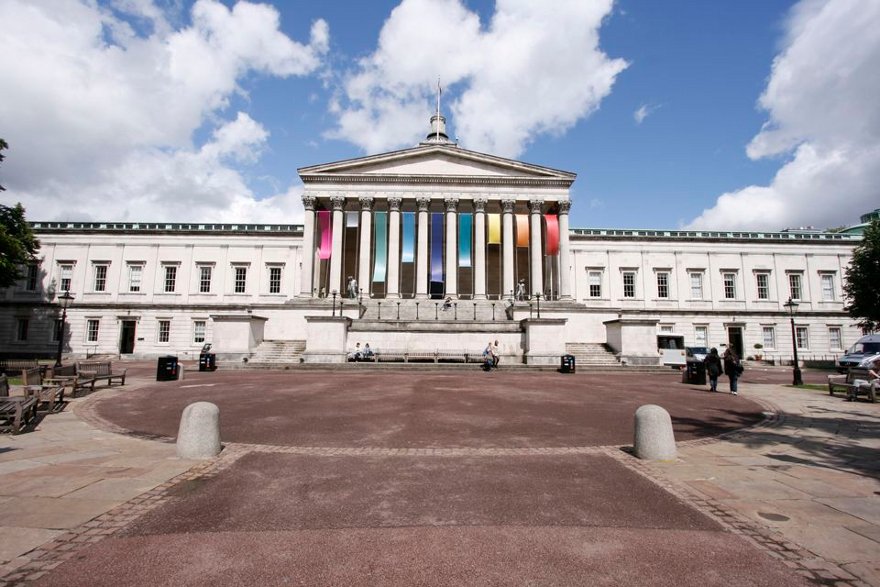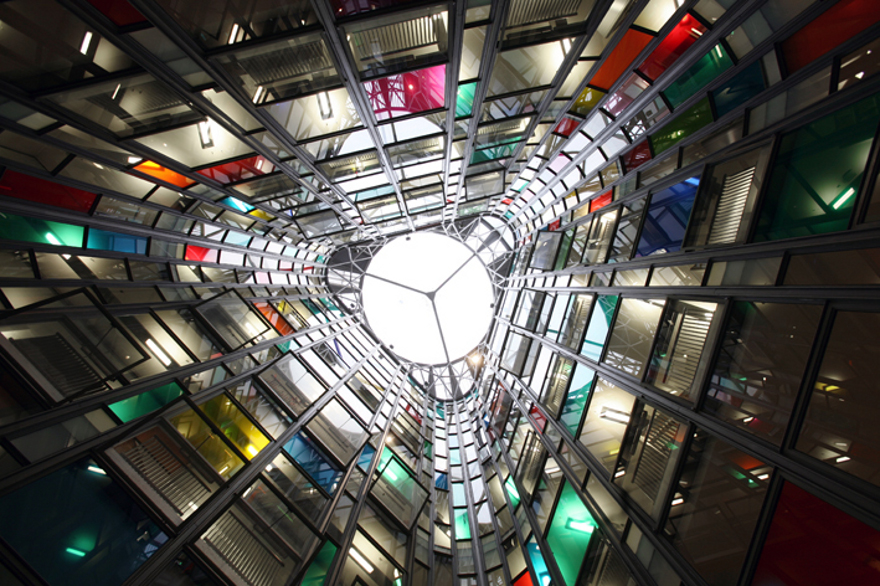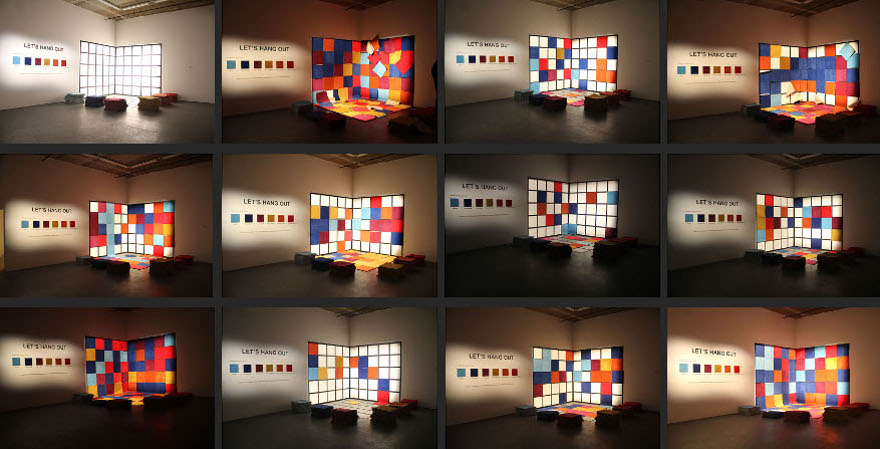
The following has been adapted from a talk given at St. Mary’s Gallery York by contemporary artist Julia Vogl, the 2012 winner of the Aesthetica Art Prize. Julia was invited to speak on the nature of success to as part of the 2013 awards event.
As artists we inevitably seek the approval of the public, but at the same time we thrive off challenging it. Artists dare to make work that is unpredictable and surprising, and yet also satisfying. From colouring the glass windows at UCL’s School of Slavonic and East European Studies to draping banners over the university’s classical portico, and an interactive installation involving 250 carpet tiles: I make work out of an impulse of wanting to communicate beyond the staid noise pollution of the gallery, and reaching out to those who don’t expect to encounter art. But I didn’t always have the courage to hold such aspirations or ambitions: prizes were a major contributing in building this confidence.
Back in 2007, I was pursuing an Honors degree in fine arts at Oberlin College in Ohio. One of the requirements was to apply to a show or competition beyond the university – I was terrified! I wanted to apply to something where I thought I had a chance but also many seemed like a lot of work and money. Then I found a listing at the back of Calendar Magazine for The National Ugly Necklace Competition. The requirements were simple: make an ugly necklace, write a poem about it and send in a photo.
My friend Maggie and I went through the junk in our studio. My post it note to-do lists became a collar with the tea strainer as a clasp, then we added twine, a flask, dried pasta, a watch, measuring cups, dried clementine peels, and biology note cards from our required science class. The poem was about barely sleeping in college. A few weeks later the phone rang. Warren Feld from Nashville Tennessee was very impressed with our necklace and telephoned to inform me that our necklace had been shortlisted for the grand prize. A few months later, Maggie and I won: $1,000 worth of jewelry supplies and our necklace was sent to Nashville to be on view!
I never thought of myself as very competitive. I think that is why I ended up in the arts.
This was a beginning of sorts for me. It wasn’t about the jewelry supplies, or the fact that my creative moment was on display in Nashville Tennessee, it was the fact that for the first time in 22 years, I could write ‘winner’ on my CV. I will proudly acknowledge that not everything about being an artist concerns the purity of the process; sometimes just a bit of recognition feels really great.
I never thought of myself as very competitive. I think that is why I ended up in the arts. You couldn’t compare a student who painted still-lifes, for example, with one who did performances that involved a cardboard box. I think that is why I enjoyed the Slade so much: every artist made completely different work and, perhaps as a consequence, there was no real rivalry – only critical conversations and peer-to-peer support. Evaluation of success became about a personal experience: could you walk away and have something to say about the work? Did it linger in the mind, prompting new thoughts and conversations?
At the opening for the Aesthetica Art Prize, I was in conversation with someone on staff, who said that some of the films they reviewed for their festival were all over the map, but one had been particularly shocking. I asked if they selected that one. She laughed: “No, no, no,” she said. I was somewhat surprised; it seems so hard to find things that make us react, that can make us climb out of our skin, and six months after she had been shocked she was still sharing the story of it. Perhaps it didn’t matter that the film never made it to the festival; at least it had circulated through conversation, and had an impact that was beyond any formal evaluation.
But that said, when the arts become professionalized, building a reputation becomes increasingly important – and that depends on track record and on formal evaluation processes. This is where art and politics start to slide together. Having worked on a number of political campaigns – from Howard Dean for president in 2004 Iowa, to Margarita Lopez for Manhattan Borough President in 2005, and Barak Obama in 2008 – I’m aware that political campaigning is about statistics: data, numbers, polling. In short, winning votes! I sort of hated that we were constantly asking individuals in their doorway, at a coffee shop or on a street corner to evaluate their personal ethics and values and that, in doing the math, pick either blue for democrat or red for republican. It can’t be that easy; and why weren’t there more choices? I walked away from politics understanding that there was a lot here to unpack about the nature of human experience and agency.
Over the last four years, my work has been dedicated to data, and to the process of collecting it. When I worked on a political campaign, I was sitting on the street, with a clear agenda, but now as an artist, I wanted to go back to that street corner with no agenda – to really have a conversation with someone about their politics, about their life choices, about what they were not giving enough time to think about. More importantly I wanted to show people that they were not just a cog in a wheel, spinning round and round, but an individual with a voice that would be represented. By sharing their time with me, I would give back to them.
In 2010, I made a work called Colouring the Invisible. I was inspired by the five- storey glass atrium at the School of Slavonic and East European Studies, part of University College of London. Unaware that the atrium’s architects had been influenced by Tatlin’s Tower (himself inspired by the Tower of Babel), I asked users what languages they were fluent in, then paired that language with a colour and coated a third of the windows in the atrium with transparent coloured vinyl to match the proportions of users’ language fluency. The work was only up for two months but in that time the space was radically transformed. After it was taken down I was delighted to overhear a student telling a visitor how it had really made her think about language and nationality, and how she hadn’t realized so many of her peers were fluent in Russian.
There is always much that is not heard, and the challenge is to capture these voices.
Then, in 2011, for my degree show project at the Slade, I made ‘£1,000,000 pounds 1,000 opinions’ [pictured top], for which I surveyed 100 people at ten different stops on the Jubilee line in London and asked each one where they would allocate a million pounds of public spending. Collectively I had 1,000 opinions. I ask each person to choose from the nine categories of the Greater London Authority Budget and I then created a hyperbolic bar chart on UCL’s front portico. Each category became a colored banner, and each day represented a different tube stop. The banners went up and down each day to reflect the opinions of the different communities. The idea was to create a conversation – one that introduced the individuals on the platform to those who walk down Gower Street. For the ten-day show I sat in the quad in front of the work, even under an umbrella when it rained and listened to what people had to say. I was trying to do my own evaluation, trying to see if the work was really provoking this conversation I had aimed for.
What struck me was that beyond all the individual responses from passers-by (middle-aged joggers concerned about safety in St John’s Wood; students upset at the lack of investment in public transport) there was also another conversation taking place, one that was less articulated. It seemed everyone wanted a photo in front of the work. And not just individuals: even though the work could have been construed as a commentary on UCL’s own privileging of both data and money, the university invited the work to be photographed to adorn the next year’s undergraduate prospectus. There is always much that is not heard, and this became a challenge for my next work, to capture these voices.
For months after this project there was professional silence. Friends were being picked up by galleries, work was being bought, and I was sitting at home applying left, right and center to shows, prizes, and other opportunities that might somehow give me the recognition that I was doing the right thing, that I should be in the arts at all.
Then, whilst working on a project at the People’s Supermarket, and just as I was forgetting about freaking out about the future, an e-mail came through from Rebecca Wilson at the Saatchi Gallery: I was going to be in New Sensations. It was a reminder to me that my degree show work had a voice that was still being carried months after the work had disappeared from public view. I had to pinch myself and remind myself to maintain confidence, keep making work and not busy myself in anxiety about what was next. The fall of 2011 was busy – full of shortlistings.
Art prizes are not like winning an election. They don’t guarantee an income for four years.
If you’ve never come in second place, or been shortlisted, it is the most wonderful disappointment. I didn’t really know what to do with my emotions, so I ignored them and kept making work in my studio, kept applying for opportunities to make new work. Then in December 2011 it arrived in my inbox – “CONGRATULATIONS! You are the winner of the Aesthetica Magazine Creative Works Competition.” Had I even applied to this? In my delirium post degree show, I must have done.
Art prizes are not like winning an election. They don’t guarantee an income and job for two to four years. But they do give you a sense of confidence, even though that initial terror I felt when applying to the meaningless Ugly Necklace Competition still haunts me every time I send out my work into the world. Applying for prizes has taught me to be introspective, to really evaluate what I am proud of, what I think is successful work. What was it that made a particular work ‘just right’? How do I break down that formula and do it again, and challenge myself to do it better?
I used to work as an administrator in public art. I scoured artists’ CV and resumés all day long, seeking out the right one for a particular project or to recommend to a selection panel. It was a process of picking out artists who had the range or the aesthetic to compliment a lead architect or who had demonstrated the ability to work well within the very specific criteria of a particular brief. I learned that unlike in the professions of law, medicine and teaching, artists can take many different journeys to arrive in the professional realm. The jump from ‘emerging’ to ‘established’ is never straightforward, and doesn’t rely on a formula. I was lucky that my moment of silence was so short, that I picked myself up and made the most of even the smallest opportunity at the People’s Supermarket. Winning the Aesthetica Creative Works Prize certainly gave me confidence to be more ambitious than I could have been before, but it also gave me more rope to keep enduring in a crazy profession.

In May last year, I won the Catlin Art Prize. I was just excited that someone wanted me to make new work for a prize exhibition. For ten months I had been sitting on an idea that involved 250 carpet tiles and demanded some serious space. [pictured above] Then the Prize’s curator Justin Hammond was there, saying, “Go make it happen!”
So often my practice relies on marrying an idea and a site. It varies which comes first, but I spend a lot of time in my studio playing with Lego, collaging photographs of architectural spaces, and thinking. I also spend a great amount of time on public transport, eavesdropping and just watching the way people are. More of the actual art making happens on site, when that marriage or idea and space has been ordained. And the key ingredient is to have a community that’s game to engage – and that relies on me having done my research properly.
An art prize is as much a boost to an artist as to the institution
behind it.
It never occurred to me that winning the Catlin Prize would literarily buy me another year in this profession. It helped me financially, it gave me great press, and it introduced me as a much more serious candidate for other opportunities. It also gave me the last push I needed to pursue a self-initiated project that I had been battling with for nine months – HOME, a massive public audio-visual project for Peckham during the Olympics. Shortlisted for the Sky Ignition Future fund £30,000, it had failed to win, but the process had encouraged me to pursue the project anyway – with financing coming through an Arts Council application, Kickstarter campaign, in-kind donations, and a partnership with Southwark Council, Resonance FM, Peckham Space and the now closed Peckham Settlement local community center. The project taught me to persevere, that you don’t have to wait for a brief that matches the art you want to make.
I still don’t like competitions. I like the challenge of making new work, coming up with new ideas, but I don’t like rejection, and, believe me, I have a high frequency of it! But they are still incredibly important – especially for ‘emerging’ artists. The art prizes I have received might be celebrating the achievement of one previous made work, but in impact the prize is a recognition of my future potential, and almost a challenge to do better, bigger, bolder.
At the same time, it’s important to realize that an art prize effectively makes you an ambassador for the institution who awarded it. An art prize is perhaps just as much a boost to an individual artist as to the people or institution behind it, and the future patrons who invest in that artist. Not all prizes are just based on talent, some awarding bodies seem to look for ambition and self-determination, even previous winning credentials. Sometimes it is as much a PR exercise for the awarding body as it is a celebration of an artist’s achievements.
Ultimately the suitability of each prize depends on the work and ethos of the individual artist. Winning a prize is almost like insurance – an implicit statement that somehow guarantees this artist is nowhere close to giving up; they have a lot more ideas where this ‘win’ came from, and we should all stick around to see what they do next. As an artist, this kind of support is very flattering, and helps to instill the confidence to keep at it. And, of course, the money is always nice.
Julia Vogl is an artist whose social sculpture incorporate public engagement, architectural interventions and colour. She is resolved to create experiences and memories for the viewer, prompting discourse, while creating aesthetically rich works.
www.juliavogl.com
This articles was developed during Cooking Up the Left-Overs, a series of editorial workshops undertaken as part of Re:THINK, a festival organised by innovative charity 3Space, who temporarily take over commercial properties to make them available to charities.
3Space.org
www.artcatlin.com

Add new comment